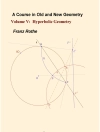This volume is a collection of research surveys on the Distance Geometry Problem (DGP) and its applications. It will be divided into three parts: Theory, Methods and Applications. Each part will contain at least one survey and several research papers.
The first part, Theory, will deal with theoretical aspects of the DGP, including a new class of problems and the study of its complexities as well as the relation between DGP and other related topics, such as: distance matrix theory, Euclidean distance matrix completion problem, multispherical structure of distance matrices, distance geometry and geometric algebra, algebraic distance geometry theory, visualization of K-dimensional structures in the plane, graph rigidity, and theory of discretizable DGP: symmetry and complexity.
The second part, Methods, will discuss mathematical and computational properties of methods developed to the problems considered in the first chapter including continuous methods (based on Gaussian and hyperbolic smoothing, difference of convex functions, semidefinite programming, branch-and-bound), discrete methods (based on branch-and-prune, geometric build-up, graph rigidity), and also heuristics methods (based on simulated annealing, genetic algorithms, tabu search, variable neighborhood search).
Applications will comprise the third part and will consider applications of DGP to NMR structure calculation, rational drug design, molecular dynamics simulations, graph drawing and sensor network localization.
This volume will be the first edited book on distance geometry and applications. The editors are in correspondence with the major contributors to the field of distance geometry, including important research centers in molecular biology such as Institut Pasteur in Paris.
Tabla de materias
Preface.- 1. Universal Rigidity of Bar Frameworks in General Position (A. Alfakih).- 2. Mixed Volume and Distance Geometry Techniques for Counting Euclidean Embeddings of Rigid Graphs (I. Emiris, E. Tsigaridas, A. Varvitsiotis).- 3. (The discretizable molecular distance Geometry Problem Seems Easier on Proteins (L. Liberti, C. Lavor, A. Mucherino).- 4. Spheres Unions and Intersections and Some of Their Applications in Molecular Modeling (M. Petitjean).- 5. Is the Distance Geometry Problem in NP? (N. Beeker, S. Gaubert, C. Glusa, L. Liberti).- 6. Solving Spatial Constraints with Generalized Distance Geometry (L. Yang).- 7. A Topological Interpretation of the Walk Distances (P. Chebotarev, M. Deza).- 8. Distance Geometry Methods for Protein Structure Determination (Z. Voller, Z. Wu).- 9. Solving the discretizable molecular distance geometry problem by multiple realization trees (P. Nucci, L. Nogueira, C. Lavor).- 10.-ASAP – An Eigenvector Synchronization Algorithm for the Graph Realization Problem (M. Cucuringu).- 11. Global Optimization for Atomic Cluster Distance Geometry Problems (M. Locatelli, F. Schoen).- 12. Solving molecular distance geometry problems using a continuous optimization approach (R. Lima, J.M. Martinez).- 13. DC Programming Approaches for Distance Geometry Problems (H. Thi, T. Dinh).- 14. Stochastic Proximity Embedding (D. Agrafiotis, D. Bandyopadhyay, E. Yang).- 15. Distance Geometry for Realistic Molecular Conformations.- 16. Distance Geometry in Structural Biology (T. Malliavin, A. Mucherino, M. Nilges).- 17. Using a Distributed SDP Approach to Solve Simulated Protein Molecular Conformation Problems (X. Fang, K-C. Toh).- 18. An Overview on Protein Structure Determintion by NMR – Historical and Future Perspectives of the Use of Distance Geometry Methods.-Index.






